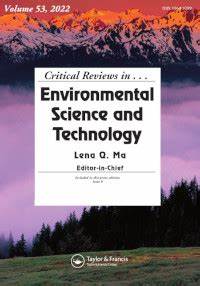Occurrence and remediation of chlorinated paraffins in global environmental matrices: Levels, trends, and future prospects
IF 13.2
1区 环境科学与生态学
Q1 ENVIRONMENTAL SCIENCES
Critical Reviews in Environmental Science and Technology
Pub Date : 2025-10-06
DOI:10.1080/10643389.2025.2566941
引用次数: 0
Abstract
Chlorinated paraffins (CPs), especially short-chain (SCCPs) and medium-chain (MCCPs) homologues, have become a global concern due to their highly toxic and persistent. However, there remains a limited and fragmented understanding of their distribution and hotspots across diverse environmental matrices worldwide, and research on effective control measures is even more deficient. This study investigated the global occurrence of CPs in multiple environmental matrices and reviewed existing degradation technologies. Emissions from industrial activities, product usage and environmental matrices exchanges have led to widespread CPs contamination mainly encompassing SCCPs and MCCPs, with average concentrations of 10−3–103 ng/m3 in atmosphere, 10–103 ng/L in water and 1–105 ng/g dw in sediment, as well as 1–106 ng/g dw in soil. In contrast, data on long-chain CPs (LCCPs) remain extremely limited. The available long-term atmospheric monitoring demonstrated both the effectiveness of regulatory controls and the delayed environmental response due to long-range atmospheric transport. The environmental migration of CPs is strongly influenced by carbon chain length and degree of chlorination. Current degradation technologies primarily focus on pyrolysis, photolysis, photocatalysis, microbial degradation, and phytoremediation. Mechanisms and efficiency analyses revealed that major challenges include by-products and the limited scalability of technologies beyond laboratory settings. By systematically linking contaminations profiles to suitable treatment options, we proposed a targeted CPs pollution remediation strategy. These insights aim to advance global CPs government and support the implementation of the Stockholm Convention.氯化石蜡在全球环境基质中的发生和修复:水平、趋势和未来展望
氯化石蜡(CPs),特别是短链石蜡(SCCPs)和中链石蜡(MCCPs)的同源物,由于其高毒性和持久性已成为全球关注的问题。然而,对其在世界范围内不同环境基质中的分布和热点的认识仍然有限且支离破碎,有效控制措施的研究更是缺乏。本研究调查了全球多种环境基质中CPs的分布情况,并对现有的降解技术进行了综述。来自工业活动、产品使用和环境基质交换的排放导致了广泛的氯化石蜡污染,主要包括短链氯化石蜡和MCCPs,大气中的平均浓度为10−3-103 ng/m3,水中为10 - 103 ng/L,沉积物中为1-105 ng/g / w,土壤中为1-106 ng/g / w。相比之下,关于长链CPs (lccp)的数据仍然非常有限。现有的长期大气监测既证明了监管控制的有效性,也证明了远程大气输送造成的环境响应延迟。CPs的环境迁移受到碳链长度和氯化程度的强烈影响。目前的降解技术主要集中在热解、光解、光催化、微生物降解和植物修复等方面。机制和效率分析显示,主要挑战包括副产品和实验室环境之外技术的有限可扩展性。通过系统地将污染概况与合适的处理方案联系起来,我们提出了有针对性的CPs污染修复策略。这些见解旨在推动全球CPs政府并支持《斯德哥尔摩公约》的实施。
本文章由计算机程序翻译,如有差异,请以英文原文为准。
求助全文
约1分钟内获得全文
求助全文
来源期刊
CiteScore
27.30
自引率
1.60%
发文量
64
审稿时长
2 months
期刊介绍:
Two of the most pressing global challenges of our era involve understanding and addressing the multitude of environmental problems we face. In order to tackle them effectively, it is essential to devise logical strategies and methods for their control. Critical Reviews in Environmental Science and Technology serves as a valuable international platform for the comprehensive assessment of current knowledge across a wide range of environmental science topics.
Environmental science is a field that encompasses the intricate and fluid interactions between various scientific disciplines. These include earth and agricultural sciences, chemistry, biology, medicine, and engineering. Furthermore, new disciplines such as environmental toxicology and risk assessment have emerged in response to the increasing complexity of environmental challenges.
The purpose of Critical Reviews in Environmental Science and Technology is to provide a space for critical analysis and evaluation of existing knowledge in environmental science. By doing so, it encourages the advancement of our understanding and the development of effective solutions. This journal plays a crucial role in fostering international cooperation and collaboration in addressing the pressing environmental issues of our time.

 求助内容:
求助内容: 应助结果提醒方式:
应助结果提醒方式:


